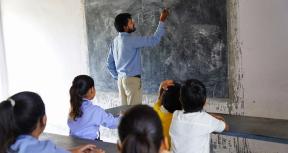Evidence tells us that learning delivered through basic education (i.e. primary and lower secondary education) is central to the wellbeing of individuals and the development of economies.
Yet the world is facing a learning crisis in which too many young people have been left behind. The World Bank identified this “moral and economic crisis” in its 2018 World Development Report (WDR). A year later, it found a staggering 91% of children under 10 in low-income countries were in learning poverty, meaning they were not able to read a simple text, fluently, in their own language. In comparison, this applied to only 9% of children in high-income countries.
Since then, the situation has only gotten worse. Because many developing countries struggled to pivot to online learning during school closures brought on by the COVID-19 pandemic, many more children have suffered learning losses. In low-income countries, the rate of learning poverty increased to 92% by the end of 2022.
Examining the World Bank’s strategy for supporting basic education
Addressing the learning crisis and supporting basic education is a core aim of the World Bank, which is the world’s biggest external funder of education in low- and middle-income countries. A new report by the Independent Evaluation Group (IEG) assesses a decade’s worth of Bank support, from 2012 to 2022, for improving basic education in partner countries, from 2012 and 2022.
Over this decade, the World Bank has successfully built awareness, shared knowledge and convened global stakeholders around a commitment to quality basic education. Its data, analytics and publication of the 2018 WDR have drawn attention to the learning crisis and helped to define learning poverty. The evaluation finds that this improved analytical understanding of the challenges involved in tackling learning poverty has encouraged buy-in from other stakeholders.
The evaluation also finds that World Bank projects promoting basic education in developing countries performed relatively well in delivering outputs, such as more teachers and new curricula, that contribute to education quality.
While these outputs are useful, the evaluation identified potential for World Bank projects to have a more sustained impact on addressing the learning crisis. Many projects lacked an outcome orientation, meaning their success was not measured with reference to improvements in learning outcomes. Nor did such projects provide evidence that the inputs were effectively improving education quality (e.g., teacher training resulting in improved pedagogical practices). In addition, most were not accompanied by a comprehensive review or analysis of how different elements of the education system fit together to affect learning outcomes.
If we cannot understand why systems are failing children, we cannot make changes to the intertwined challenges that result in learning poverty. The causes of failure can involve stakeholders at levels other than the central government. The World Bank typically focuses its attention at the central, state, or provincial government level. This gives it a comparative advantage in influencing education policy. However, this often means that agencies within the government and at decentralized levels of administration, who implement policy, get less capacity-building support from the World Bank. It can also result in a lack of engagement with other key actors in the education system who influence the implementation of policy, such as teachers, trade unions, parents, nongovernmental organizations, and civil society organizations (CSOs).
Recommendations to enhance the World Bank’s impact on basic education
How can the World Bank scale up the impact of its activities on the global education crisis? IEG’s evaluation makes two clear recommendations:
1. Adopt a systems-level focus on outcomes
As central to improving learning outcomes, the World Bank should develop country-specific education engagement plans that introduce systems-based improvements to the teaching career framework. A teaching career framework consists of models for recruitment and training of teachers, selecting and deploying them in schools, and motivating and monitoring them over the course of their career. An effective framework is a critical ingredient for capable and motivated teachers, who are vital to improving learning outcomes. But implementing teaching career frameworks can run up against several systems-level constraints. An analysis and understanding of these systemic constraints should inform the Bank’s engagement plans.
Along with understanding systemic constraints, addressing them requires continuity of engagement. The report found that the Bank’s often limited and time bound financial and analytical support in many countries made it difficult to gain sufficient traction for the systemic transformations needed for an improved teaching career framework.
Nonetheless, the Bank’s status as the largest funder of education and its strong relationships with governments mean it is well placed to play a major role in delivering a more strategic and outcomes-focused approach to the learning crisis. This approach should recognize the unique characteristics of individual countries and their education systems, including:
- The political commitment to education system reform in a country;
- Levels of public funding; and
- The education system’s capacity to deliver learning for all children.
2) Leverage partnerships to close data gaps and foster learning-oriented systems
Partnerships are key to delivering strategic improvements to systems and outcomes. The evaluation found that, where the World Bank had a willing and committed partner, it has been able to focus its support on reforms and actions that foster a learning-oriented education system. For example, its work in Brazil, Kenya and Vietnam benefited from the countries’ strong political and financial commitment in support of learning for all.
The report also recommends that the Bank enhances its collaboration with global and country partners to close data gaps on learning outcomes and track progress towards ending learning poverty.
A few ways that the Bank can demonstrate and measure this would be through an increase in the number of countries with (1) education projects and Country Partnership Frameworks (CPFs) that include indicators for learning improvements in grades 3 and 6, which may require more ambitious project goals and indicators; (2) improvement in national educational assessment capabilities and systems for data collection and decision-making; and (3) participation in cross-national assessments for better data comparability.
Addressing the learning crisis is an important end, but enhancing learning outcomes will also improve the ability to solve other critical development challenges. The recommendations in this evaluation could help the World Bank improve education systems around the world and give young people the knowledge and skills both to improve their lives and grow the countries they live in.









Add new comment